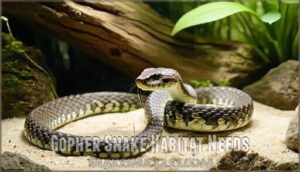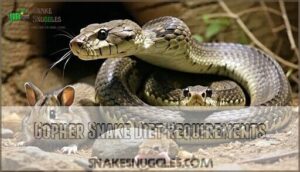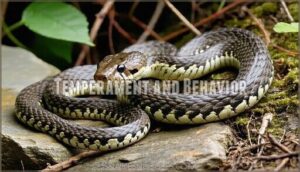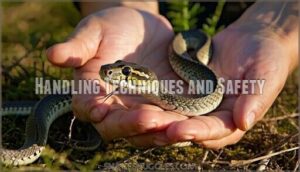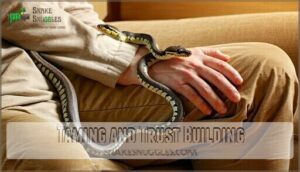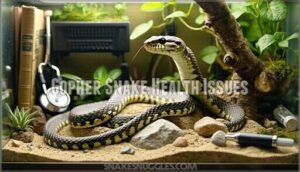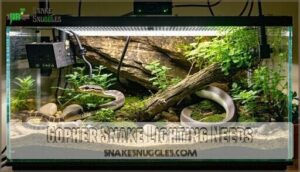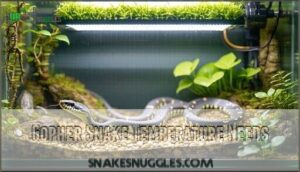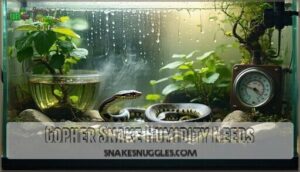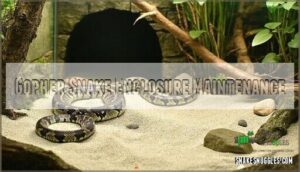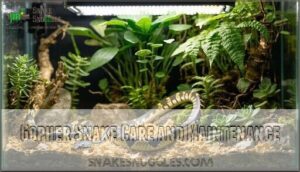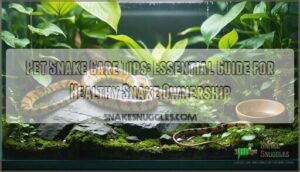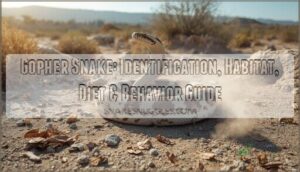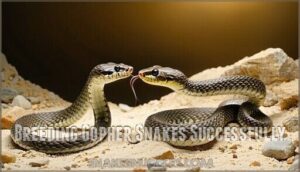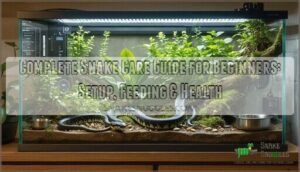This site is supported by our readers. We may earn a commission, at no cost to you, if you purchase through links.
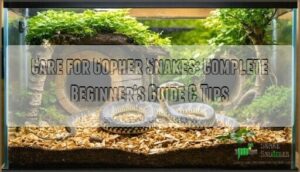
Provide aspen shavings or cypress mulch as substrate, along with hiding spots on both warm and cool sides.
Feed appropriately-sized frozen-thawed rodents every 7-14 days, adjusting frequency based on your snake’s age and size.
Maintain 30-50% humidity with a water bowl and occasional misting.
These docile constrictors rarely bite but may hiss dramatically when startled—think of it as their way of saying "please give me space."
Spot-clean waste immediately and perform monthly deep cleans.
The secret to successful gopher snake keeping lies in understanding their unique behavioral quirks and environmental preferences.
Table Of Contents
- Key Takeaways
- Gopher Snake Habitat Needs
- Gopher Snake Diet Requirements
- Handling Gopher Snakes
- Gopher Snake Health Issues
- Gopher Snake Lighting Needs
- Gopher Snake Temperature Needs
- Gopher Snake Humidity Needs
- Gopher Snake Enclosure Maintenance
- Gopher Snake Care and Maintenance
- Frequently Asked Questions (FAQs)
- Conclusion
Key Takeaways
- You’ll need a 40-gallon enclosure with temperature gradients of 75-85°F, proper substrate for burrowing, and hiding spots on both warm and cool sides to create an ideal habitat.
- Feed your gopher snake appropriately-sized frozen-thawed rodents every 7-14 days based on age, while maintaining 30-50% humidity with occasional misting and fresh water.
- Handle your snake gently and consistently to build trust – they’re docile constrictors that rarely bite but may hiss defensively when startled or stressed.
- Maintain daily spot-cleaning, weekly water changes, and monthly deep cleans while monitoring for common health issues like respiratory problems, mites, and shedding difficulties.
Gopher Snake Habitat Needs
Creating proper habitat conditions is essential for your gopher snake’s health and wellbeing.
You’ll need to carefully consider enclosure dimensions, substrate choices, and environmental enrichment to replicate their natural living conditions.
Enclosure Size Requirements
You’ll need to size up your gopher snake’s enclosure properly to guarantee their wellbeing.
Adult snakes require a minimum tank size of 40 gallons with dimensions of 48 inches long, 24 inches wide, and 24 inches deep.
Your enclosure length should match your snake’s body length for adequate snake space.
Consider habitat depth for burrowing behavior, as these terrestrial species love digging.
A bioactive enclosure setup provides the best long-term solution for your pet’s health.
Proper snake enclosure designs are vital for creating a suitable environment.
Substrate Options
Your gopher snake’s substrate choice directly impacts their natural burrowing behaviors and overall health. Proper substrate depth of at least 2 inches allows for instinctual digging while maintaining appropriate moisture levels for shedding cycles.
Here are five substrate options that’ll keep your snake comfortable:
- 60/40 sand-soil mix – mimics natural desert conditions perfectly
- Zoo Med Reptisand – provides excellent drainage and natural texture
- Bioactive substrate blend – supports beneficial microorganisms and plants
- Pure play sand – affordable option that holds burrows well
- Terra Firma/Terra Sahara mix – premium commercial reptile substrate.
Sand options work exceptionally well since gopher snakes are natural burrowers. Soil mix combinations retain some moisture without becoming soggy. Bioactive substrate creates a self-sustaining ecosystem but requires more setup knowledge.
Avoid cedar or pine shavings, which can cause respiratory irritation in your slithery friend.
Decor and Enrichment
Beyond basic hideouts, you’ll want to create visual barriers using decorating enclosure elements like cork bark and artificial plants.
These decor options provide environmental enrichment while reducing stress.
Climbing structures encourage natural behaviors, making your terrarium size feel larger.
Consider bioactive enclosure setups with live plants for ultimate snake enclosure decor and hideout designs.
When designing the habitat, understanding temperature regulation methods is essential for creating a suitable environment.
Gopher Snake Diet Requirements
Proper nutrition forms the foundation of successful gopher snake husbandry, with specific prey types and feeding schedules varying based on your snake’s age and size.
Understanding these dietary requirements will help you maintain your gopher snake’s health and prevent common feeding-related issues that can affect their growth and longevity.
Food Types and Sizes
When choosing prey items for your gopher snake diet, you’ll want to match food sizes to your snake’s widest body point.
Frozen-thawed mice provide complete snake nutrition while eliminating parasite risks that live prey carries. Understanding the snake’s natural wild food habits is vital for creating a suitable diet.
Here are the essential rodent types by life stage:
- Hatchlings: Pinky mice weekly – tiny but perfectly sized for those adorable baby snakes
- Juveniles: Fuzzy to hopper mice – watching them grow feels like watching your own kid hit growth spurts
- Subadults: Adult mice or small rats – they’re getting serious about their nutrient needs now
- Adults: Large mice to medium rats – these impressive eaters deserve impressive meals
Feeding Frequency and Schedule
Establishing consistent feeding schedules helps your gopher snake thrive while preventing obesity and digestive issues.
Hatchlings require meals every 5-10 days, juveniles need feeding every 7-10 days, and adults should eat every two weeks.
Young snakes eat weekly, adults every two weeks—their growing bodies need fuel more often than mature appetites.
This feeding frequency allows proper digestion between meals, as young snakes have faster metabolisms, requiring more frequent nutrition than mature adults, which is crucial for ideal snake health**.
Stick to these schedules religiously for optimal results.
Supplementation and Nutrition
While whole prey provides most nutrients your gopher snake needs, strategic supplementation guarantees maximal health.
Frozen-thawed rodents can lose some vitamins during storage, making targeted nutritional variety beneficial for long-term wellness.
Here are three key supplementation strategies:
- Dust prey with Repashy Calcium Plus LoD monthly to address potential vitamin D3 and mineral deficiencies in captive snake diet
- Rotate food sources between mice, rats, and occasional chicks to provide dietary enrichment and broader nutrient profiles
- Monitor body condition rather than following rigid schedules – healthy snakes with proper reptile nutrition rarely need frequent supplements
Handling Gopher Snakes
When you handle gopher snakes properly, they typically remain calm and rarely bite despite their intimidating defensive displays.
Most gopher snakes become increasingly docile with regular, gentle handling sessions that help them recognize you as non-threatening, and this process can make them rarely bite.
Temperament and Behavior
Gopher snakes display a remarkably docile nature in captivity, though their defensive behaviors can startle newcomers.
When threatened, they’ll coil, hiss loudly, and flatten their heads to mimic rattlesnakes.
Watch for stress factors like rapid breathing or excessive hiding. Understanding snake body language helps you recognize aggression signs early.
Their defensive postures are mostly bluff—true snake aggression is rare in well-cared-for specimens.
Handling Techniques and Safety
Proper snake handling starts with confidence and calm movements.
Support your gopher snake’s body at multiple points, never grabbing just the head or tail.
Watch for defensive behavior like hissing, coiling, or mock striking – these venomous lookalikes can fool predators but won’t harm you.
Use gentle restraint techniques, moving slowly to avoid triggering snake aggression.
Always wash hands before and after handling sessions to prevent snake bite infections and maintain snake safety through consistent handling tips.
Taming and Trust Building
Building trust with your gopher snake requires patience and consistency. Start with short handling sessions to avoid overwhelming your pet, as frequent gentle interactions help establish positive associations with human contact.
Trust isn’t built overnight—it’s earned through gentle, consistent interactions that respect your snake’s comfort zone.
- Snake Handling Sessions: Begin with 5-minute sessions twice weekly, gradually increasing duration as your snake becomes comfortable.
- Trust Exercises: Allow your gopher snake to explore your hands freely without restraint, letting them set the pace.
- Gentle Touch Techniques: Use slow, deliberate movements when approaching, avoiding sudden gestures that trigger defensive responses.
- Calming Methods: Speak softly during interactions and maintain consistent body temperature to create predictable bonding experiences.
Gopher Snake Health Issues
While gopher snakes are generally hardy reptiles, you’ll need to watch for several common health issues that can affect your pet’s wellbeing.
Understanding these problems and knowing when to seek veterinary care will help guarantee your snake lives a long, healthy life.
Common Health Problems
Unfortunately, gopher snake health can hit a few bumps.
Respiratory issues from improper humidity cause wheezing and mouth breathing.
Mite infestations lead to anemia and constant scratching.
Shedding problems create retained skin that harbors infections.
Internal parasites cause weight loss and digestive upset.
Snake diseases like mouth rot develop from poor hygiene.
Watch for these red flags.
Gopher snakes are prone to respiratory disease issues that can be caused by various factors, including poor husbandry practices.
Gopher snakes are prone to respiratory disease issues that can be caused by various factors, including poor husbandry practices.
Prevention and Treatment
Through consistent disease prevention and health monitoring, you’ll catch snake health issues early.
Maintain proper temperatures, humidity, and cleanliness to prevent respiratory issues and mites.
For wound care, keep injuries clean and dry.
Control parasites through quarantine protocols and regular substrate changes, and treat infections promptly with appropriate medications while monitoring your snake’s behavior and appetite daily, to ensure overall health and prevent issues like respiratory problems and infections.
Veterinary Care and Check-ups
Regular veterinary visits form the cornerstone of preventive snake health care, helping detect issues before they become serious problems.
Schedule annual health checks with a reptile-experienced veterinarian who can perform medical tests, assess overall condition, and provide emergency care guidance.
While snake vaccines aren’t typically required, your vet can recommend specific reptile health protocols and create personalized snake care guidelines for ideal wellness.
Gopher Snake Lighting Needs
Proper lighting creates a natural day-night cycle that supports your gopher snake’s biological rhythms and overall health.
You’ll need to provide both bright daytime illumination and UVB radiation to replicate the conditions these diurnal reptiles experience in their native habitats, which is essential for their biological rhythms.
UVB Lighting Requirements
UVB lighting supports vitamin D3 synthesis in your gopher snake, promoting calcium metabolism and bone health.
Install Arcadia T5 HO Forest or Zoo Med T5 HO Reptisun bulbs covering half your enclosure.
Maintain 14-hour summer and 10-hour winter lighting cycles.
Position bulbs 11-20 inches above basking spots for proper intensity levels.
These UVB benefits include enhanced activity, natural behaviors, and vibrant coloration in your snake.
Temperature and Lighting Gradients
Thermal gradients create essential temperature zones across your snake’s enclosure.
Position your basking lamp at one end to achieve 85°F surface temperatures, while maintaining 70-75°F on the cool side.
This temperature gradient allows your gopher snake to thermoregulate naturally by moving between zones.
Always use a thermostat with heat sources to prevent dangerous temperature spikes that could harm your pet.
Proper heat lamp selection is vital for maintaining ideal temperatures, considering the heat lamp types available for your gopher snake’s enclosure.
This is crucial for creating a safe and healthy environment for your gopher snake.
Photoperiod and Circadian Rhythms
Your gopher snake’s internal clock needs proper light cycles to maintain healthy diurnal behavior.
Provide 14 hours of UVB lighting during summer months, reducing to 10 hours in winter to mimic natural photoperiod effects.
This day-night rhythm supports their circadian rhythms, encouraging natural activity patterns and proper temperature gradient utilization throughout their enclosure.
Gopher Snake Temperature Needs
Creating proper temperature gradients guarantees your gopher snake can thermoregulate effectively and maintain prime health.
You’ll need to establish a thermal gradient with a basking spot around 85°F and a cool side between 70-75°F, using appropriate heating equipment to maintain these critical temperature zones throughout your snake’s enclosure.
Basking and Ambient Temperatures
Establishing proper basking temperatures creates the foundation for your gopher snake’s health and natural behaviors.
Your snake needs specific thermal zones to regulate its body temperature effectively throughout the day.
Create these essential temperature zones in your enclosure:
- Basking spot at 85°F – measured directly on the surface using a digital probe thermometer
- Ambient air temperature of 70-75°F – maintained on the cool side away from heat sources
- Nighttime drop to 65-70°F – allowing natural cooling when lights turn off
- Temperature gradient across enclosure – enabling your snake to choose ideal thermal comfort zones
This thermal gradient mimics your snake’s natural desert habitat, where they bask on warm rocks during the day and retreat to cooler burrows when needed.
Maintaining a proper temperature gradient is vital for the overall health and well-being of your gopher snake.
Heating Sources and Equipment
Proper heating equipment creates the thermal foundation your gopher snake needs to thrive.
Heat lamps with halogen bulbs provide the most natural warmth, mimicking sunlight’s infrared spectrum.
Always pair heating sources with reliable thermostats for precise temperature control.
When selecting heat lamps, consider the benefits of heat lamp systems for ideal temperature regulation.
| Equipment Type | Best Use | Temperature Control |
|---|---|---|
| Halogen Heat Bulbs | Primary basking heat | Dimming thermostat |
| Ceramic Heat Emitters | Nighttime supplemental heat | On/off thermostat |
| Heat Mats | Under-tank warming | Proportional thermostat |
Heat mats work well as supplemental heating but shouldn’t be your primary source since gopher snakes naturally bask above ground, requiring a primary basking heat source for their well-being.
Temperature Gradients and Fluctuations
Once you’ve got your heat sources dialed in, creating effective temperature gradients becomes your next priority.
You’ll want a smooth thermal drop from your 85°F basking spot down to the 70-75°F cool zone.
This gradient gives your snake options for thermoregulation throughout the day.
Your thermostat controls these fluctuations automatically, preventing dangerous temperature spikes while maintaining consistent heating and lighting cycles that mirror natural thermal patterns, ensuring a stable environment for consistent heating.
Gopher Snake Humidity Needs
Proper humidity management keeps your gopher snake healthy and supports essential processes like shedding. You’ll need to maintain average air humidity below 60% while providing access to humid microclimates when needed.
Humidity Levels and Requirements
Maintaining humidity levels between 30-50% keeps your gopher snake healthy and comfortable.
Humidity above 60% can cause scale rot and respiratory infections, while levels below 30% lead to dehydration and shedding problems.
Use digital humidity gauges to monitor moisture levels accurately throughout the enclosure.
Proper humidity control supports natural behaviors and prevents stress-related health issues in captive snakes.
Humid Hideouts and Microclimates
Your gopher snake needs access to humid microclimates for successful shedding.
Create a humid hide using a plastic container with an entrance hole, lined with damp sphagnum moss. This hideout designs a moisture-rich zone within your bioactive enclosure.
Position it on the cooler side where substrate naturally retains humidity. Check moisture levels weekly, keeping the moss damp but not dripping to maintain proper microclimate control.
Maintaining Optimal Humidity
Achieving ideal humidity involves creating microclimates within your snake enclosure while preventing excessive moisture buildup that can lead to respiratory issues.
- Monitor ambient humidity – Keep general air humidity below 60% using a digital hygrometer
- Provide humid hides – Line hideouts with moist sphagnum moss for shedding support
- Control evaporation rates – Use water dishes sized appropriately to prevent oversaturation
- Maintain bioactive enclosure balance – Guarantee proper drainage layers prevent waterlogged substrate
- Adjust water management – Replace water weekly and spot-clean moisture-retaining areas
Gopher Snake Enclosure Maintenance
Proper enclosure maintenance keeps your gopher snake healthy and prevents disease outbreaks that can quickly turn serious.
You’ll need to establish consistent cleaning routines, monitor substrate conditions, and manage water quality to create a thriving environment for your pet, which includes maintaining a proper environment through consistent cleaning routines.
Cleaning and Disinfection
Regular cleaning keeps your snake enclosure healthy and odor-free. Start with daily spot-cleaning to remove waste immediately – this prevents bacterial growth and maintains air quality.
Weekly water changes using reptile-safe disinfectant eliminate harmful pathogens effectively.
| Cleaning Task | Frequency | Method | Products |
|---|---|---|---|
| Waste Removal | Daily | Spot clean immediately | Paper towels, tongs |
| Water Dish | Weekly | Scrub and disinfect | Reptile-safe disinfectant |
| Surface Cleaning | Bi-weekly | Wipe all surfaces | Diluted bleach solution |
| Full Enclosure | Monthly | Complete breakdown | Commercial reptile cleaner |
Your sanitation routine should include proper hygiene practices like washing hands before and after handling. Choose disinfectant options specifically formulated for reptile care – household cleaners can be toxic.
Monthly deep cleaning involves removing all substrate and décor, then sanitizing everything thoroughly before reassembly.
Substrate Replacement and Maintenance
Beyond daily spot-cleaning comes substrate maintenance that keeps your gopher snake’s home healthy long-term.
Replace bioactive enclosure substrate every six to twelve months, depending on soil mixtures and terrarium size.
Monitor substrate depth regularly – it should remain at least two inches for proper burrowing behavior.
Fresh substrate prevents bacterial buildup while maintaining humidity control essential for reptile care.
Water and Hydration Management
Fresh water deserves the same attention you give substrate maintenance. Your gopher snake’s water bowl requires weekly washing with reptile-safe disinfectant to prevent bacterial growth.
Fill it with dechlorinated water that’s deep enough for drinking but shallow enough to prevent drowning. Monitor your snake’s drinking habits, as increased consumption may signal health issues or humidity problems requiring adjustment.
Maintaining proper humidity, around 40-60% for gopher snakes, is also essential for their well-being.
Gopher Snake Care and Maintenance
Successful gopher snake care requires consistent daily monitoring and weekly maintenance tasks to guarantee your snake’s health and well-being.
You’ll need to establish a routine that includes observing behavioral changes, maintaining proper environmental conditions, and providing enrichment opportunities that stimulate natural behaviors.
Daily and Weekly Care Tasks
Establishing consistent gopher snake care routines helps maintain your pet’s health and creates a stress-free environment.
Daily tasks include checking temperatures, spot-cleaning waste, and replenishing water, while weekly responsibilities involve thorough tank cleaning and feeding schedule adherence.
- Daily Waste Management: Remove uneaten food within 24 hours and spot-clean feces immediately to prevent bacterial growth
- Weekly Snake Feeding: Stick to your established feeding schedule, offering appropriately-sized prey every 7-14 days depending on age
- Humidity Control Checks: Monitor humidity levels daily and adjust water dish size or misting frequency as needed
Monitoring and Observing Behavior
Observing your gopher snake’s behavior patterns reveals essential health information.
Watch for normal snake posture during basking, gentle tongue flicking, and consistent activity levels.
Body language changes signal stress or illness before physical symptoms appear.
| Normal Behavior | Stress Indicators |
|---|---|
| Relaxed coiling | Head hiding/retraction |
| Steady tongue flicking | Hissing or mock striking |
| Active exploration | Escape attempts |
| Normal respiration | Rigid body posture |
Monitor snake behavior daily during feeding and handling.
Note seasonal changes in activity levels, as gopher snakes naturally become less active during winter months.
Document unusual behaviors like excessive hiding or aggressive responses to help your veterinarian assess health issues early.
Providing Environmental Enrichment
You can transform your gopher snake’s terrarium from basic housing into an engaging habitat through thoughtful decor options and sensory stimulation.
Visual barriers like cork bark create security, while climbing structures encourage natural behaviors.
Consider environmental rotation—swapping substrate textures or repositioning UVB lighting monthly keeps your snake mentally active.
A bioactive enclosure with live plants maximizes terrarium size benefits while providing ongoing enrichment through natural processes.
Frequently Asked Questions (FAQs)
Are gopher snakes good for beginners?
Like a steady rock in turbulent waters, gopher snakes make excellent beginner reptiles. You’ll appreciate their docile temperament, hardy constitution, and straightforward care requirements that won’t overwhelm new keepers.
Can gopher snakes be housed together safely?
No, gopher snakes can’t be housed together safely.
They’re strictly solitary animals and will stress each other out or potentially become aggressive.
You’ll need separate enclosures for each snake to keep them healthy and happy.
What permits are required for ownership?
Permit requirements vary by state.
Most states don’t require permits for gopher snakes since they’re nonvenomous, but you’ll need to check your specific state regulations.
Contact your local wildlife department for definitive answers on ownership requirements.
How long do gopher snakes typically live?
In captivity, you’ll find gopher snakes typically live between 12-15 years with proper care.
With a record of 33 years 10 months for a Great Basin gopher snake, exceptional longevity’s achievable through ideal husbandry.
Are gopher snakes good for beginner keepers?
Think of choosing a pet snake as selecting your first car—you want something reliable that won’t overwhelm you.
Gopher snakes make excellent beginner reptiles because they’re docile, hardy, and forgiving of minor husbandry mistakes while requiring straightforward care requirements.
How much does gopher snake ownership cost?
Initial setup costs around $200-400 for a proper terrarium, heating, lighting, and substrate. You’ll spend $20-40 monthly on frozen mice, plus occasional veterinary visits averaging $100-200 annually for health maintenance.
Conclusion
Successfully learning to care for gopher snakes requires dedication, patience, and consistent attention to detail.
These remarkable reptiles thrive when you provide proper habitat conditions, maintain feeding schedules, and respect their behavioral needs.
Your commitment to temperature gradients, humidity levels, and enrichment directly impacts their health and longevity.
Remember that each snake develops its own personality—some remain shy while others become confident.
With proper preparation and ongoing maintenance, you’ll discover that these docile constrictors make rewarding companions for dedicated keepers.
- https://reptilesupply.com/blogs/how-to-guides/how-to-set-up-a-gopher-snake-bullsnake-enclosure
- https://www.anapsid.org/gopher.html
- https://dubiaroaches.com/blogs/snake-care/gopher-snake-care-sheet
- https://www.snakeestate.com/gopher-snakes/sonoran-gopher-snake/
- https://www.wilbanksreptiles.com/blogs/gopher-snake-blog/exploring-the-gopher-snakes-self-defense-tactics

